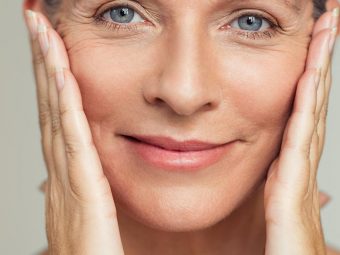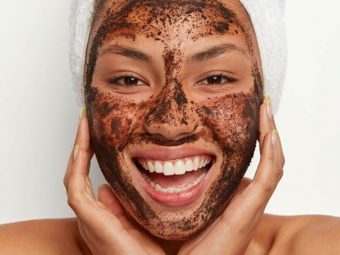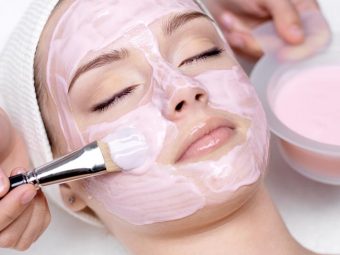9 DIY Fruit Face Masks For Glowing Skin
Enjoy the rejuvenating effects of these homemade fruity masks to get radiant skin.

Fruits are rich in nutrients like vitamins and minerals necessary for your body’s overall health and beautiful, clear, and glowing skin. That’s why fruit face masks for glowing skin are so popular. They provide your skin with all the natural nutrients and help you avoid chemical-based facials. Using fruit masks offers therapeutic spa-like advantages to your skin. They also relax and destress your skin. These are some of the most significant benefits that make these cost-effective and natural fruit facials preferable. Here, we have compiled a list of some of the best simple fruit face masks that you may make at home. Check them out.
In This Article
Homemade Fruit Packs For Glowing Skin
- Papaya And Honey Face Pack
- Kiwi And Avocado Face Pack
- Banana Face Pack
- Tomato Face Pack
- Orange Peel Face Pack
- Cucumber And Milk Pack
- Strawberry And Chocolate Pack
- Grapes and Apple Face Pack
- Hydrating Mango Face Pack
1. Papaya And Honey Face Pack
Papaya is rich in vitamin A and an enzyme called papain, which has exfoliating properties that help remove dead skin cells. It also helps in enhancing the complexion. The fruit also contains anti-inflammatory and anti-viral properties that may help reduce acne (1). Therefore, it relaxes and soothes acne-prone skin. Papaya also reduces premature aging. It makes the skin firm and fades fine lines, scars, and blemishes. It nourishes your skin, making it look brighter, moisturized, and glowing.
You Will Need
- 2 pieces of papaya
- 1 teaspoon of honey
Directions
- Blend the papaya into a nice, smooth pulp and add the honey to it.
- Apply the mixture generously on clean, dry skin.
- Allow it to rest for about 15 to 20 minutes.
- Wash your face with cold water and pat dry.
- Apply a moisturizer.
Caution: Although there could be no adverse reactions when you use a natural fruit pack, it is best to do a patch test before you apply it to your face.
2. Kiwi And Avocado Face Pack
Avocados are rich in antioxidants. They contain alpha and beta-carotenes that quench the free radicals, thus protecting your skin from environmental damage and visible signs of premature aging (2), (3). Avocados are also rich in healthy fats that are excellent for maintaining healthy skin.
Avocados also contain generous amounts of vitamins C and E that help in enhancing skin health. They have a high content of oleic acid, a monounsaturated fatty acid that disrupts the skin barrier and enhances the permeability of other ingredients in the mask (4).
Kiwis, like avocados, are enriched with vitamins C and E and antioxidants that help boost collagen and rejuvenate the skin, thus improving skin elasticity and making it look youthful and glowing (5).
You Will Need
- 1 avocado
- 1 kiwi
- 1 teaspoon of honey
Directions
- Peel the avocado and kiwi and mash them together into a smooth, creamy paste.
- Add the honey and mix well.
- Apply the paste to your face and neck and leave it on for about 30 minutes.
- Rinse with water and pat your skin dry. Don’t forget to moisturize your skin.
3. Banana Face Pack
Banana contains vitamin B6, vitamin C, silica, potassium, and other nutrients that are vital for the elasticity and integrity of the skin (6). It helps clear hyperpigmentation and protects the skin from sun damage. It is a perfect ingredient for dry and sensitive skin.
You Will Need
- ½ banana
- ½ teaspoon honey
- 1 teaspoon lemon juice
Directions
- Mash the banana and add the honey and lemon juice to it.
- Mix well and apply the pack on clean skin.
- Leave it on for about 20 minutes and wash it off.
Note: Avoid using lemon juice if you have dry and sensitive skin.
4. Tomato Face Pack
Tomatoes contain lycopene, powerful antioxidants, and vitamins B, C, and E. These nutrients help maintain your skin by absorbing more oxygen, which not only delays aging but also protects the skin against the harmful UV rays (7),(8). Tomatoes help in reducing tan and brightening the skin as well. However, there is insufficient scientific evidence to prove their effect on the skin when applied topically.
You Will Need
- 1 tomato
- 1 tablespoon oatmeal
- 1 teaspoon yogurt
Directions
- Blend the tomatoes into a smooth and pulpy consistency.
- Add the oatmeal and yogurt to the tomatoes.
- Apply this mask to your face and neck. Leave it on for 10 minutes and then wash it off.
Caution: Yogurt contains lactic acid. If you have sensitive skin, avoid using it.
5. Orange Peel Face Pack
Orange peels are high in antioxidants and vitamin C. They help protect your skin against UV damage (9). Orange peel extracts contain various compounds that exhibit anti-aging properties (10). Due to this, your skin may look more bright and radiant than ever.
You Will Need
- 3 oranges
- 1 tablespoon yogurt
- 1 teaspoon honey
Directions
- Peel three oranges and save the skin.
- Break the peels into small bits and rinse them. Spread them out and allow them to dry in the sun for about three days.
- Once the peels are dry, powder them. You could store the orange peel powder in a clean, dry bottle.
- For the pack, mix two teaspoons of orange peel powder with the honey and the yogurt and apply on clean skin. Leave it on for about 20 minutes, and then wash your face.
- You can also use a store-bought orange peel powder.
6. Cucumber And Milk Pack
Cucumbers deliver high anti-inflammatory, therapeutic, and rejuvenating properties that may help revive dull and dry skin (11). It is 96% water, which makes it perfect for hydrating your skin. It helps smoothen your skin and relieve it from itching. It calms irritated skin. It also helps brighten your skin and reduces wrinkles (12).
You Will Need
- ½ cucumber
- ¼ cup milk
- 1 tablespoon of honey
- 1 tablespoon of brown sugar
Directions
- Peel a cucumber and blend it to make a puree.
- Mix the milk, honey, and brown sugar, and once it emulsifies well, add the cucumber puree to it.
- Apply this mixture to your face and leave it on for about 20 minutes. Wash your face and pat dry.
Caution: Milk has lactic acid. If you have sensitive skin, do not use this remedy.
7. Strawberry And Chocolate Pack
Strawberries are rich in essential vitamins and minerals. They contain vitamin C that fights free radicals and delays premature aging. They also help to lighten the skin, owing to the ellagic acid present in them. This also helps reduce and fade spots and blemishes. The manganese and antioxidants tone the skin, and the alpha-hydroxy acid cleanses the skin and eliminates dead cells. This also helps reduce wrinkles (13). The anthocyanin pigments protect the skin against the harmful UV rays (14). Chocolate, especially dark chocolate, contains antioxidants that make the skin look youthful and protect it from early aging and UV damage. Add note on benefits of cocoa for skin
You Will Need
- 4 strawberries
- 1 tablespoon cocoa powder
- 1 teaspoon honey
Directions
- Blend the strawberries until they become a smooth pulp.
- Add cocoa powder and honey to this pulp.
- Apply this pack on your face and leave it on for about 15 minutes. Wash it off with warm water and pat dry for gorgeous, glowing skin.
8. Grapes and Apple Face Pack
Apple contains vitamin C that helps build collagen. It contains powerful antioxidants and polyphenols that protect your skin from UV damage and aging. However, more scientific evidence is needed to prove its effectiveness in improving skin health.
Apples contain malic acid, which makes the skin radiant and smooth. It also has humectant properties.
Grapes are rich in vitamin C that helps in toning and firming the skin. It also contains antioxidants like flavonoids, tannins, and resveratrol that fight free radicals and inhibit wrinkle formation (15).
Note: If you have dry skin, do not use this remedy as vitamin C can dry out your skin further.
You Will Need
- ½ apple
- 7 grapes
Directions
- Blend the apple and the grapes until you get a smooth, soft paste.
- Apply on clean skin and leave it on for half an hour. Wash and pat dry.
9. Mango Face Mask
Mango contains antioxidants that have anti-inflammatory effects on your skin (16). It also contains beta-carotene and vitamins C and E that help fight free radicals. These nutrients, together, help keep your skin healthy from within.
You Will Need
- 1 ripe mango
- 2-3 teaspoons of Fuller’s earth
Directions
- Remove all the pulp of a ripe mango and mash it until it is smooth. Add Fuller’s earth to it and make a thick, smooth paste.
- Apply this pack to your face and neck and leave it on for about 30 minutes.
- Once the pack dries, wash it off, scrubbing gently in circular motions.
The following are a few tips to keep in mind when you make these DIY face packs.
Tips To Keep In Mind Before Using Fruit Facials
- Make sure the masks are always applied on skin that is cleansed and exfoliated. Exfoliation will not only remove dead skin but also enhance blood circulation, which will improve the results of the pack.
- Make sure you blend the fruit well so that you can extract as much pulp as possible.
- Make sure all your chores are done, and your mind is relaxed when you do the facial. You need to sit still when you apply the pack. Not only will it allow the pack to rest and prevent it from sliding off your face, but it will also help you calm down and unwind.
- Make sure you are wearing old clothes as fruit packs ought to be messy.
- Some fruit pulps are extremely fluid; they will not remain on your skin. To thicken the paste, you can add oats to the fruit pulp.
- When you apply a pack, you should cover both the face and the neck, as they are both exposed to the environment equally.
- Adding these ingredients to the fruits will definitely amp up their benefits.
- Honey – Hydrates the skin and improves acne resistance.
- Lemon Juice – Kills bacteria, reduces blemishes, improves complexion, and fights acne.
- Yogurt – Removes excessive oil, protects the skin against harmful rays of the sun, and reduces tanning. It also makes your skin smooth and soft.
- Milk – It acts as a great cleansing and moisturizing agent. It enhances skin elasticity and improves the complexion as well.
- Green Tea – It helps in rejuvenating the skin.
- Avoid heading out in the sun a day or two after applying these fruit face packs. Give your skin ample time to rejuvenate after the face packs. Apply sunscreen and use sun protection gear such as scarves, hats, etc.
Fruits are an essential part of a balanced diet as they promote your overall health. They can also promote your skin health if included in your skin care regimen in the form of fruit masks. These fruit packs for glowing skin also offer several other benefits, like destressing the skin and being cost-effective. You can use fruits like mango, grapes, strawberry, kiwi, papaya, and banana. If you find any of these packs are extremely fluid, you can add oats to the pulp to thicken. Applying these packs to exfoliated skin helps increase their effectiveness.
Frequently Asked Questions
Is it good to apply fruits to the face?
Yes, it is good to apply fruits to the face. They help enhance skin glow. However, do not apply fruits that may cause allergic reactions to your skin.
What should we eat for glowing skin?
Consume vitamin-rich fruits and vegetables, fatty fish, nuts, and seeds to improve skin glow. Also, drink enough water to enhance skin health.
Sources
- Aravind, G., et al. “Traditional and medicinal uses of Carica papaya.” Journal of Medicinal Plants Studies 1.1 (2013): 7-15.
https://www.researchgate.net/publication/285028880_Traditional_and_medicinal_uses_of_Carica_papaya - Rosenblat, Gennady et al. “Polyhydroxylated fatty alcohols derived from avocado suppress inflammatory response and provide non-sunscreen protection against UV-induced damage in skin cells.” Archives of dermatological research vol. 303,4 (2011): 239-46.
https://pubmed.ncbi.nlm.nih.gov/20978772/ - Dreher, Mark L, and Adrienne J Davenport. “Hass avocado composition and potential health effects.” Critical reviews in food science and nutrition vol. 53,7 (2013): 738-50.
https://pubmed.ncbi.nlm.nih.gov/23638933/ - Mack Correa, Mary Catherine et al. “Molecular interactions of plant oil components with stratum corneum lipids correlate with clinical measures of skin barrier function.” Experimental dermatology vol. 23,1 (2014): 39-44.
https://www.ncbi.nlm.nih.gov/pmc/articles/PMC4068283/ - Deters, Alexandra M et al. “Kiwi fruit (Actinidia chinensis L.) polysaccharides exert stimulating effects on cell proliferation via enhanced growth factor receptors, energy production, and collagen synthesis of human keratinocytes, fibroblasts, and skin equivalents.” Journal of cellular physiology vol. 202,3 (2005): 717-22.
https://pubmed.ncbi.nlm.nih.gov/15389574/ - Kumar, KP Sampath, et al. “Traditional and medicinal uses of banana.” Journal of Pharmacognosy and Phytochemistry 1.3 (2012): 51-63.
https://www.researchgate.net/publication/285484754_Traditional_and_medicinal_uses_of_banana - Stahl, Wilhelm et al. “Lycopene-rich products and dietary photoprotection.” Photochemical & photobiological sciences : Official journal of the European Photochemistry Association and the European Society for Photobiology vol. 5,2 (2006): 238-42.
https://pubmed.ncbi.nlm.nih.gov/16465309/ - Rizwan, M et al. “Tomato paste rich in lycopene protects against cutaneous photodamage in humans in vivo: a randomized controlled trial.” The British journal of dermatology vol. 164,1 (2011): 154-62.
https://pubmed.ncbi.nlm.nih.gov/20854436/ - Yoshizaki, Norihiro et al. “Orange peel extract, containing high levels of polymethoxyflavonoid, suppressed UVB-induced COX-2 expression and PGE2 production in HaCaT cells through PPAR-γ activation.” Experimental dermatology vol. 23 Suppl 1 (2014): 18-22.
https://pubmed.ncbi.nlm.nih.gov/25234831/ - Apraj, Vinita D, and Nancy S Pandita. “Evaluation of Skin Anti-aging Potential of Citrus reticulata Blanco Peel.” Pharmacognosy research vol. 8,3 (2016): 160-8.
https://www.ncbi.nlm.nih.gov/pmc/articles/PMC4908842/ - Mukherjee, Pulok K et al. “Phytochemical and therapeutic potential of cucumber.” Fitoterapia vol. 84 (2013): 227-36.
https://pubmed.ncbi.nlm.nih.gov/23098877/ - Kim, So Jung et al. “Skin whitening and anti-corrugation activities of glycoprotein fractions from liquid extracts of boiled sea cucumber.” Asian Pacific journal of tropical medicine vol. 9,10 (2016): 1002-1006.
https://pubmed.ncbi.nlm.nih.gov/27794379/ - Markiewicz, Agata et al. “An evaluation of the antiaging properties of strawberry hydrolysate treatment enriched with L-ascorbic acid applied with microneedle mesotherapy.” Journal of cosmetic dermatology vol. 18,1 (2019): 129-135.
https://pubmed.ncbi.nlm.nih.gov/29663691/ - Gasparrini, Massimiliano et al. “Strawberry-Based Cosmetic Formulations Protect Human Dermal Fibroblasts against UVA-Induced Damage.” Nutrients vol. 9,6 605.
https://www.ncbi.nlm.nih.gov/pmc/articles/PMC5490584/ - Kim, Jungeun et al. “Grape Peel Extract and Resveratrol Inhibit Wrinkle Formation in Mice Model Through Activation of Nrf2/HO-1 Signaling Pathway.” Journal of food science vol. 84,6 (2019): 1600-1608.
https://pubmed.ncbi.nlm.nih.gov/31132143/ - Song, Jae Hyoung et al. “Protective effect of mango (Mangifera indica L.) against UVB-induced skin aging in hairless mice.” Photodermatology, photoimmunology & photomedicine vol. 29,2 (2013): 84-9.
https://pubmed.ncbi.nlm.nih.gov/23458392/












